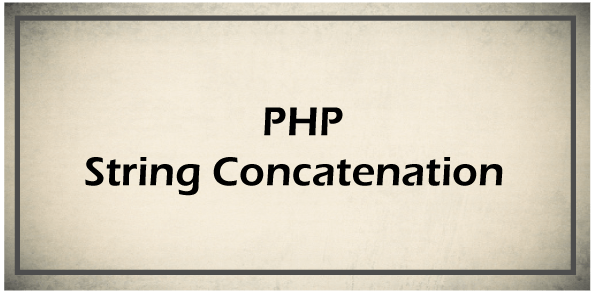PHP 字符串连接
在本文中,我们将学习如何在PHP中进行字符串连接。我们将学习PHP字符串的基础知识,并通过各种示例来了解这个概念。
什么是PHP中的字符串
字符串是一系列字符的集合。它提供了各种类型的字符串操作符,这些操作符具有不同的功能,例如字符串连接、比较值和执行布尔运算。

PHP字符串连接运算符用于在PHP中连接字符串。PHP提供了两种类型的字符串运算符。
1. 连接运算符(“.”)
在PHP中,该运算符用于将两个字符串值组合在一起,并将其作为新字符串返回。
让我们看一下如何在PHP中使用连接运算符(“.”)来连接字符串的各种示例。
示例1:
<! Doctype html>
<html lang="en">
<head>
<meta charset="utf-8">
<meta name="viewport" content="width=device-width, initial-scale=1, shrink-to-fit=no">
<title> String Concatenate Example in PHP </title>
<style>
body
{
margin-top: 20px;
text-align: center;
padding: 20px 20px 20px 20px;
background-color: lightgrey;
}
h2 {
font-style: italic;
font-family: "Playfair Display","Bookman",serif;
color: black;
letter-spacing: -0.005em;
word-spacing: 1px;
font-size: 1.75em;
font-weight: bold;
}
h3 {
font-style: italic;
font-family: "Playfair Display","Bookman",serif;
color: black;
letter-spacing: -0.005em;
word-spacing: 1px;
border: green 3px solid;
font-size: 1em;
font-weight: bold;
}
</style>
<body>
<h2> String Concatenate Example in PHP </h2>
</body>
</html>
<?php
a = 'Hello ';b = 'PHP';
c =a . b;
// print Concatenate String
echo "<h3>c \n </h3>";
?>
解释:
在上面的示例中,我们将两个字符串连接在第三个字符串中。在这个示例中,我们使用了两个字符串类型的变量a和b,并且$c变量也是字符串类型,存储了连接后的字符串。
$c = $a . $b;
为此,我们使用了连接运算符(.)将字符串连接起来。
输出:
下图示例了此示例的输出:

示例2:
<! Doctype html>
<html lang="en">
<head>
<meta charset="utf-8">
<meta name="viewport" content="width=device-width, initial-scale=1, shrink-to-fit=no">
<title> String Concatenate Example in PHP </title>
<style>
body
{
margin-top: 20px;
text-align: center;
padding: 20px 20px 20px 20px;
background-color: lightgrey;
}
h2 {
font-style: italic;
font-family: "Playfair Display", "Bookman",serif;
color: black;
letter-spacing: -0.005em;
word-spacing: 1px;
font-size: 1.75em;
font-weight: bold;
}
h3 {
font-style: italic;
font-family: "Playfair Display", "Bookman",serif;
color: black;
letter-spacing: -0.005em;
word-spacing: 1px;
border: green 3px solid;
font-size: 1em;
font-weight: bold;
}
</style>
<body>
<h2> String Concatenate Example in PHP </h2>
</body>
</html>
<?php
// First String
fname = 'I LOVE PHP';
// Second Stringlname = 'PHP is my favorite subject';
// Concatenation of String
c =fname." ".lname;
echo " <h3>c </h3>\n";
?>
解释:
在上面的示例中,我们将两个字符串连接在第三个字符串中。在这个示例中,我们使用了两个变量fname和lname作为字符串类型,并且变量$c也是字符串类型,其中存储了连接后的字符串。
$c = $fname." ".$lname;
为了达到这个目的,我们使用了字符串连接运算符(.)来连接字符串。
输出:
下图演示了此示例的输出:

2. 连接赋值运算符(”.=”)
该操作将右边的参数追加到左边的参数。
让我们来看一下如何使用连接赋值运算符(”.=”)来连接PHP中的字符串的各种示例。
示例1:
<! Doctype html>
<html lang="en">
<head>
<meta charset="utf-8">
<meta name="viewport" content="width=device-width, initial-scale=1, shrink-to-fit=no">
<title> String Concatenate Example in PHP </title>
<style>
body
{
margin-top: 20px;
text-align: center;
padding: 20px 20px 20px 20px;
background-color: lightgrey;
}
h2 {
font-style: italic;
font-family: "Playfair Display", "Bookman",serif;
color: black;
letter-spacing: -0.005em;
word-spacing: 1px;
font-size: 1.75em;
font-weight: bold;
}
h3 {
font-style: italic;
font-family: "Playfair Display", "Bookman",serif;
color: red;
letter-spacing: -0.005em;
word-spacing: 1px;
border: green 3px solid;
font-size: 1em;
font-weight: bold;
}
</style>
<body>
<h2> String Concatenate Example in PHP </h2>
</body>
</html>
<?php
// First String
string1 = 'Concatenate';
// nowstring1 contains "HelloWorld!"
string1.= "two strings in One variable";
// Print The Stringstring1
echo "<h3> $string1 </h3> \n";
?>
解释:
在上面的示例中,我们将两个字符串连接到一个字符串变量中。我们使用了一个变量 $string1 来存储连接的字符串。为此,我们使用了连接赋值运算符 (“.=”) 来连接字符串。
$string1 = 'Concatenate';
// now $string1 contains "HelloWorld!"
$string1.= "two strings in One variable";
输出:
下图展示了此示例的输出:

示例2:
<! Doctype html>
<html lang="en">
<head>
<meta charset="utf-8">
<meta name="viewport" content="width=device-width, initial-scale=1, shrink-to-fit=no">
<title> String Concatenate Example in PHP </title>
<style>
body
{
margin-top: 20px;
text-align: center;
padding: 20px 20px 20px 20px;
background-color: lightgrey;
}
h2 {
font-style: italic;
font-family: "Playfair Display", "Bookman",serif;
color: black;
letter-spacing: -0.005em;
word-spacing: 1px;
font-size: 1.75em;
font-weight: bold;
}
h3 {
font-style: italic;
font-family: "Playfair Display", "Bookman",serif;
color: red;
letter-spacing: -0.005em;
word-spacing: 1px;
border: green 3px solid;
font-size: 1em;
font-weight: bold;
}
</style>
<body>
<h2> String Concatenate Example in PHP </h2>
</body>
</html>
<?php
a = 'First String';b = [" Second String"," Concatenate"];
for(i = count(b)-1; i >= 0;i--) {
a .=b[i];
}
echo "<h3>a </h3>";
?>
解释:
在上面的示例中,我们已将变量连接到了数组字符串中。我们使用了变量a和字符串数组b,将连接后的字符串存储在其中。为此,我们使用了连接赋值运算符(”.=”)来连接字符串。
<?php
a = 'First String';b = [" Second String"," Concatenate"];
for(i = count(b)-1; i >= 0;i--) {
a .=b[i];
}
echo "<h3>a </h3>";
?>
输出:
下图展示了这个示例的输出结果:

 极客笔记
极客笔记